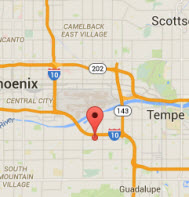Learn How To Screen Print With Catspit Productions, LLC
Screens: Understanding Frame Choices And Stretching Options
Whether or not to stretch screens in house is one of those questions that need to be addressed through analyzing your ultimate goals. Screen stretching is a completely separate aspect of screen printing that requires different skills than that of the actual printing. It also requires additional tools, supplies and/or equipment. Often times it is simply volume that will dictate the practicality of stretching your own screens. If you are a rather big shop doing some high volume printing, then stretching screens in house will undoubtedly save money and may increase print quality while reducing turnaround times.
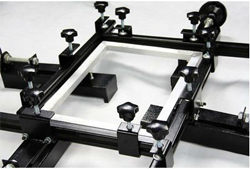 There are several ways of stretching screens which are as varied as the screens themselves. Some screens incorporate the stretching mechanism within the frame. This allows them to be re-tensioned at any time. Since mesh tension is a very important factor in proper screen performance, this may be an advantage for some printers. These types of frames are known as "dynamic" or re-tension-able frames. Screens that do not have the ability to be re-tensioned are known as static or fixed frames. Sometimes they may be referred to as rigid frames as well.
There are several ways of stretching screens which are as varied as the screens themselves. Some screens incorporate the stretching mechanism within the frame. This allows them to be re-tensioned at any time. Since mesh tension is a very important factor in proper screen performance, this may be an advantage for some printers. These types of frames are known as "dynamic" or re-tension-able frames. Screens that do not have the ability to be re-tensioned are known as static or fixed frames. Sometimes they may be referred to as rigid frames as well.
Static frames tend to be less expensive than "dynamic" frames and as you get bigger in size, the price will also increase for both types. The stability of the frame will also become an issue with larger, oversized frames. Large format screens will have very heavy duty tubing to withstand the tension of the mesh which causes bowing of frames. Bowing can cause loss of tension and thus registration problems.
Because static frames are less expensive and they can be easily stretched by a number of methods, they are often the choice of many start up textile shops. Although the rope and groove wood frame may be considered to be re-tension-able, most wood frames would be said to be static. Mesh can be attached to static wood frames using staples and staple tape or adhesives. Static metal frames need to be made with adhesives.
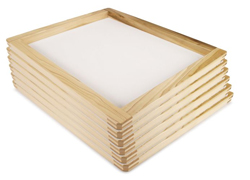 Obviously with wood frames you could use a manual "by hand" method of stretching the mesh and attaching it to the frame using staples and staple tape. All that is needed for this method is a jig to hold the frame and the hand the stretching tool which is nothing more than vice grips with a mesh grabbing bar welded to the teeth. Many hobbyists and artists will use this method because it is inexpensive. However, tension will be limited with this material and method.
Obviously with wood frames you could use a manual "by hand" method of stretching the mesh and attaching it to the frame using staples and staple tape. All that is needed for this method is a jig to hold the frame and the hand the stretching tool which is nothing more than vice grips with a mesh grabbing bar welded to the teeth. Many hobbyists and artists will use this method because it is inexpensive. However, tension will be limited with this material and method.
Static, or fixed, metal frames need to have the mesh attached with an industrial adhesive which can often have a strong odor. A stretching device is also needed to use the adhesive to attach the mesh. The stretching device may be mechanical or pneumatic. This type of equipment is not only expensive but it takes up a decent amount of space as well. This method will allow the highest mesh tensions to be achieved because the mesh may be stretched and allowed to relax. Then it is brought back to proper tension before the mesh is fixed to the frame with adhesive. Some shops will repeat this process up to 3 times or more.
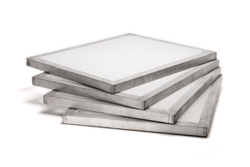 Diamond Chase and Newman Roller frames, which are re-tension-able or "dynamic", are heavy duty and very high quality but they are also expensive and heavy in weight. Roller frames are often used on large automatic textile presses because it saves some money on equipment and most importantly, it saves valuable floor space. Using a roller frame on automatic presses in high volume shops is a logical and economical solution. Diamond Chase frames are often used in circuit board nomenclature printing. They are not well suited for textile applications.
Diamond Chase and Newman Roller frames, which are re-tension-able or "dynamic", are heavy duty and very high quality but they are also expensive and heavy in weight. Roller frames are often used on large automatic textile presses because it saves some money on equipment and most importantly, it saves valuable floor space. Using a roller frame on automatic presses in high volume shops is a logical and economical solution. Diamond Chase frames are often used in circuit board nomenclature printing. They are not well suited for textile applications.
Using roller frames on manual presses can cause premature wear and break down of the print arm armature and/or print head. It also may increase fatigue on the printer due to the weight of the screen itself. Even still many smaller manual shops choose to use roller frames because they do not require stretching equipment. At a certain point this may become a personal decision as well.
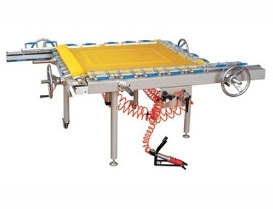 Today many smaller screen printers choose to use static aluminum screens with mesh pre-stretched on them already. This too can be an economical solution for smaller shops because the screens can be purchased with mesh for anywhere between $14 and $20 each. And with proper use and care they will last long enough to more than pay for themselves. They can also be sent out to be re-stretched if needed and when you do this once a year with a nice amount of screens, it too can be economically practical.
Today many smaller screen printers choose to use static aluminum screens with mesh pre-stretched on them already. This too can be an economical solution for smaller shops because the screens can be purchased with mesh for anywhere between $14 and $20 each. And with proper use and care they will last long enough to more than pay for themselves. They can also be sent out to be re-stretched if needed and when you do this once a year with a nice amount of screens, it too can be economically practical.
Your ultimate goals should be considered when making the decision to stretch screens in house or not. But screen stretching is one of those shop functions that you can grow over time with your shop. You can start small and not worry too much about replacing equipment because the tools needed for less expensive stretching options are always handy to keep around.

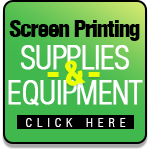
 Screenprinting Equipment From Catspit Productions
Screenprinting Equipment From Catspit Productions


